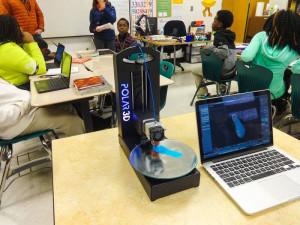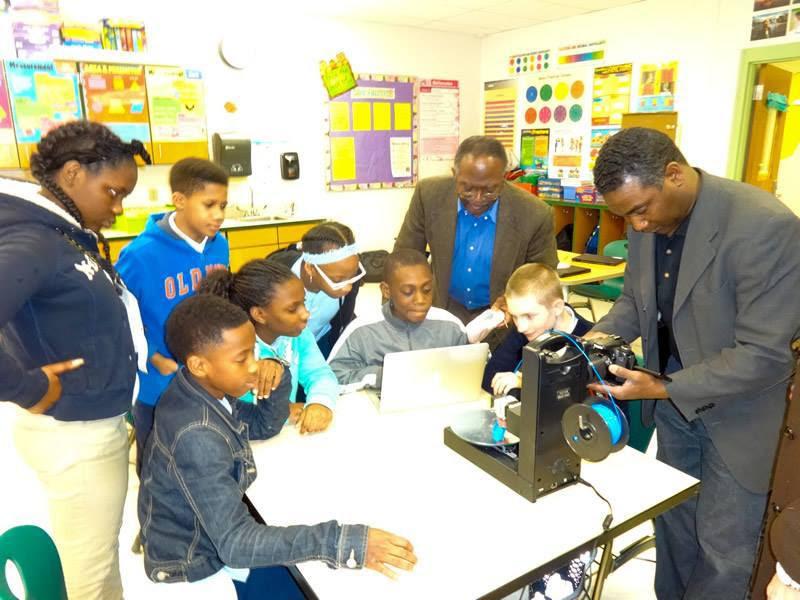 There are very few 3D printer manufacturers who aren’t involved in education to some degree. It’s a refrain we hear again and again: teaching kids about 3D printing is critical, the earlier the better, because it’s the future of every industry. While many companies have included educational outreach in their business plans, others seem to have been formed for the express purpose of putting 3D printers in classrooms. Polar 3D is one of those companies. The Cincinnati-based corporation launched their first 3D printer only a little over a year ago, and they made it clear from the very beginning that their primary goal was to get students interested in 3D printing.
There are very few 3D printer manufacturers who aren’t involved in education to some degree. It’s a refrain we hear again and again: teaching kids about 3D printing is critical, the earlier the better, because it’s the future of every industry. While many companies have included educational outreach in their business plans, others seem to have been formed for the express purpose of putting 3D printers in classrooms. Polar 3D is one of those companies. The Cincinnati-based corporation launched their first 3D printer only a little over a year ago, and they made it clear from the very beginning that their primary goal was to get students interested in 3D printing.
So far, they’ve been aggressively pursuing that goal through partnerships with leading educational and youth-oriented organizations like the Boys & Girls Clubs of America, with whom they teamed up last year to build new 3D printing labs at several club locations. Now Polar 3D is collaborating with Partnership for Innovation in Education (PIE) to develop new 3D printing curriculum for students in Cincinnati-area schools.
“Through this collaboration, PIE is able to partner with Greater Cincinnati’s leading manufacturers, engineers and product designers to take our Science Technology Engineering Math (STEM) curriculum to another level, offering students and educators a chance to use the design thinking process, develop a set of 3D prototypes and choose the solution which best solves the business challenge,” said PIE CEO Mary Welsh Schlueter. “This is the newest opportunity bridging the 21st century classroom with business, arts and engineering leaders who are constantly seeking future employees who can identify, test and develop workable solutions. Embedding 3D prototyping into our curriculum is just another way to prepare students for that future.”
PIE, also based in Cincinnati, describes its vision as “solving tomorrow’s challenges today.” The organization uses a case-based learning model to develop educational tools and programs for K-12 schools and community partners, and one of their missions is to teach younger children about technology they may not normally encounter until much later on in their education. Technology like, for example, 3D printing. A recent project involved PIE students working together with the Cincinnati Ballet to design a more ergonomic ballet shoe, using 3D modeling. Polar 3D’s curriculum will deepen students’ knowledge of 3D design and printing, taking them through the entire process from coding to modeling to prototyping.
“Just imagine, PIE students will not only create and design a better ballet shoe but also bring it out of the computer screen into their own hands and be able to refine their design all while gaining a better understanding of the creation process,” said Ed Estes, Polar 3D co-founder. “And after the ballet shoe? Hopefully it will inspire these young minds to think like entrepreneurs and create something that will change everyone’s future.”
PIE already teaches the kinds of 3D modeling skills that are normally found in graduate and undergraduate programs in design, engineering, law, business, medical and applied technology. These students are already way ahead of most others their age in terms of technological knowledge, and Polar 3D’s contributions will push them even further ahead, inspiring confidence and, ideally, giving them an early start down the path towards technological careers and entrepreneurship.
“This partnership truly allows students to direct their learning and put themselves in the role of engineer, designer and problem-solver,” said Dr. David Rosenthal, retired professor of marketing at Miami University Farmer School of Business, former president of the North American Case Research Association and former editor of the Case Research Journal. “Experiences like this empower students to envision future career pathways and help them apply what they are learning in the classroom to real-life scenarios.”
Is there a 3D printing curriculum gearing up in schools in your area? Discuss in the Polar 3D Printing Curriculum forum over at 3DPB.com.
Subscribe to Our Email Newsletter
Stay up-to-date on all the latest news from the 3D printing industry and receive information and offers from third party vendors.
Print Services
Upload your 3D Models and get them printed quickly and efficiently.
You May Also Like
Consolidation in AM: How 2025 Is Shaping the Industry’s New Normal
The first half of 2025 has been marked by a clear shift in the additive manufacturing (AM) industry. Companies are no longer just focused on developing new tech by themselves....
Etsy Design Rule Change Reduces Selection of 3D Printed Goods
Online marketplace Etsy has implemented a rule change requiring all 3D printed goods on the site to be original designs. The update to the site’s Creativity Standards states, ¨Items produced using...
U.S. Congress Calls Out 3D Printing in Proposal for Commercial Reserve Manufacturing Network
Last week, the U.S. House of Representatives’ Appropriations Committee moved the FY 2026 defense bill forward to the House floor. Included in the legislation is a $131 million proposal for...
Transforming From Tourist to Native: Duro CEO Michael Corr Explains Why the Company Rebuilt its PLM Software on AI
In these early innings of the AI boom, many market analysts have expressed concern that AI spend has gotten too far ahead of the technology’s proven ability to deliver significant...


































